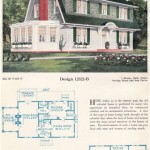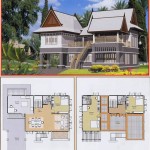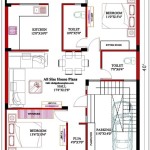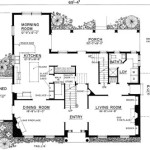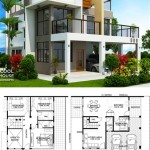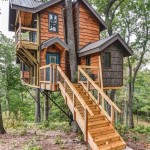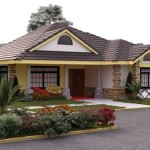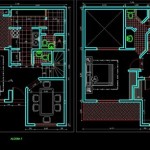Small Modern Urban House Plans: Maximizing Space and Style
Urban living presents unique challenges and opportunities for homeowners. Limited space often necessitates creative solutions to achieve comfortable and stylish living environments. Small modern urban house plans are designed to address these constraints, focusing on efficient space utilization, minimalist aesthetics, and integration with the surrounding urban landscape. These plans emphasize functionality, sustainability, and adaptability to meet the demands of contemporary urban lifestyles.
The core principle behind small modern urban house plans is to maximize every square foot of available space. This is achieved through a variety of design strategies, including open floor plans, multi-functional rooms, vertical expansion, and strategic use of natural light. The goal is to create a living space that feels larger and more comfortable than its actual footprint suggests.
Modern aesthetics play a significant role in the design of these houses. Clean lines, simple forms, and a focus on natural materials are characteristic features. Large windows and glass doors are often incorporated to connect the interior spaces with the exterior environment, blurring the boundaries between inside and out. The overall design philosophy emphasizes simplicity, functionality, and a connection to the urban context.
Prioritizing Functionality and Space Efficiency
One of the key characteristics of small modern urban house plans is the emphasis on functionality. Every element of the design is carefully considered to serve a specific purpose and contribute to the overall efficiency of the living space. This often involves incorporating features such as built-in storage, multi-functional furniture, and adaptable room layouts.
Open floor plans are commonly used in small modern urban houses to create a sense of spaciousness. By eliminating unnecessary walls and partitions, the living, dining, and kitchen areas can flow seamlessly into one another, creating a more open and airy environment. This allows for greater flexibility in furniture arrangement and facilitates social interaction among occupants.
Multi-functional rooms are another important aspect of space efficiency. A single room can be designed to serve multiple purposes, such as a home office that doubles as a guest bedroom or a living room that can be easily converted into a entertainment area. This requires careful planning and the use of flexible furniture and storage solutions.
Vertical expansion is a common strategy in urban areas where land is scarce. Building upwards allows homeowners to increase the living space without expanding the footprint of the house. This can involve adding a second story, creating a loft space, or utilizing the basement as a living area. Vertical expansion requires careful consideration of structural integrity and building codes.
Strategic use of natural light is crucial for maximizing the sense of space and well-being in a small urban house. Large windows and skylights can bring ample natural light into the interior, making the space feel brighter and more inviting. Light-colored walls and reflective surfaces can further enhance the effect of natural light. Proper window placement can also provide passive solar heating and reduce the need for artificial lighting.
Built-in storage solutions are essential for keeping a small urban house organized and clutter-free. This can include custom-built cabinets, shelves, and drawers that maximize the use of available space. Storage can be integrated into walls, under stairs, and in other underutilized areas. The goal is to provide ample storage without sacrificing valuable living space.
The selection of furniture is also critical in a small modern urban house. Compact and multi-functional furniture pieces are often preferred, such as sofa beds, nesting tables, and storage ottomans. These pieces can serve multiple purposes and save valuable space. Lightweight and easily movable furniture can also enhance the flexibility of the living space.
Embracing Minimalist Aesthetics and Sustainable Design
Modern aesthetics are characterized by clean lines, simple forms, and a focus on natural materials. This minimalist approach is ideally suited for small urban houses, as it helps to create a sense of calm and order in a limited space. By eliminating unnecessary ornamentation and clutter, the focus is placed on the essential elements of the design.
Natural materials such as wood, stone, and glass are often used in modern urban house designs. These materials add warmth and texture to the interior, creating a more inviting and comfortable atmosphere. Exposed brick walls, wooden beams, and concrete floors are common features that can add character and depth to the space.
Sustainable design principles are increasingly important in modern urban house plans. This involves incorporating energy-efficient features, using eco-friendly materials, and minimizing the environmental impact of the building. Sustainable design can not only reduce energy consumption and lower utility bills but also improve the indoor air quality and create a healthier living environment.
Energy-efficient windows and doors are essential for reducing heat loss and gain in a small urban house. Double-paned or triple-paned windows with low-E coatings can significantly improve the energy efficiency of the building. Proper insulation of walls, roofs, and floors is also crucial for minimizing energy consumption.
Renewable energy sources, such as solar panels, can be integrated into the design of a small urban house to generate electricity and reduce reliance on fossil fuels. Solar water heaters can also be used to provide hot water for domestic use. These technologies can help to reduce the environmental footprint of the building and lower energy costs.
Water conservation is another important aspect of sustainable design. Low-flow toilets, showerheads, and faucets can significantly reduce water consumption. Rainwater harvesting systems can be used to collect rainwater for irrigation and other non-potable uses. These measures can help to conserve water and reduce water bills.
The choice of building materials can also have a significant impact on the sustainability of a small urban house. Eco-friendly materials, such as recycled wood, bamboo, and recycled concrete, can reduce the environmental impact of the building. Low-VOC paints and finishes can improve the indoor air quality and create a healthier living environment.
Integrating with the Urban Context and Personalizing the Space
Small modern urban houses are often designed to integrate seamlessly with the surrounding urban context. This can involve incorporating architectural elements that reflect the style of the neighborhood, using materials that complement the existing buildings, and creating outdoor spaces that connect with the urban environment.
The facade of the house can be designed to blend in with the surrounding streetscape while still maintaining a modern aesthetic. This can involve using similar materials, colors, and architectural details as the neighboring buildings. Large windows and balconies can provide views of the urban landscape and connect the interior spaces with the exterior environment.
Outdoor spaces, such as balconies, patios, and roof gardens, can provide valuable living space in a small urban house. These spaces can be used for dining, relaxing, and entertaining, and they can also provide a connection to nature. Vertical gardens and green walls can be incorporated to add greenery and improve the air quality in the urban environment.
Personalizing the space is essential for making a small urban house feel like home. This can involve incorporating personal touches, such as artwork, photographs, and souvenirs, that reflect the individual's personality and style. The choice of furniture, colors, and accessories can also contribute to the overall aesthetic and create a comfortable and inviting living environment.
Customizing the design is often necessary to meet the specific needs and preferences of the homeowner. This can involve modifying the floor plan, adding or removing walls, and selecting specific finishes and fixtures. Working with an architect or designer can help to ensure that the house is tailored to the individual's lifestyle and requirements.
The use of technology can also enhance the functionality and convenience of a small modern urban house. Smart home systems can be used to control lighting, heating, security, and entertainment, creating a more comfortable and efficient living environment. Wireless audio systems and home theaters can provide entertainment without taking up too much space.
By carefully considering the principles of space efficiency, minimalist aesthetics, and sustainable design, homeowners can create small modern urban houses that are both functional and stylish. These houses can provide a comfortable and inviting living environment in the heart of the city, offering a unique blend of urban living and modern design.

59 3 Story Duplexes Ideas House Floor Plans Design

Small Urban House Plans Double Floor New Style Modern Home Designs Bungalow Design Model Duplex

Small Modern House Designs Plan 4x6 Meter Samphoas

Blog On Modern Architecture Design Development And Modative Happenings Small House

Small Urban House Plans Double Floor New Style Modern Home Designs Design Beautiful

House Plan 5 Bedrooms 2 Bathrooms Garage 3279 Drummond Plans

Blog On Modern Architecture Design Development And Modative Happenings Small House

Affordable Modern Two Story House Plan With Large Deck On Second Floor 9690

Urban Home Design How To Fit Your Dreams Into A Narrow Lot

House Plan 3 Bedrooms 1 5 Bathrooms Garage 1701 Drummond Plans

